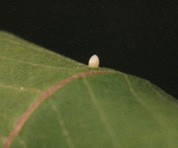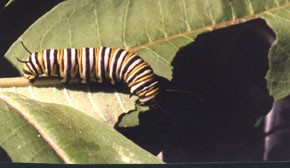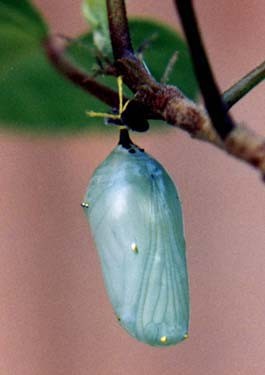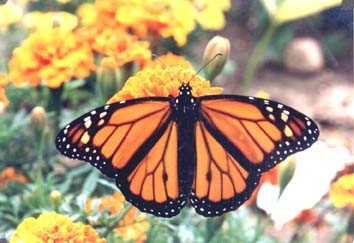



Lesson Plan
Lesson: Changing Butterflies
Date: December 6, 2005
Subject: Science
Objectives: Students will identify the stages of a butterfly’s life cycle. Students will have an understanding of the concept of metamorphoses.
Standards: 12.A.2a Describe simple life cycles of plants and animals and the similarities and differences in their offspring.
Materials:
shoe box
fake butterfly
pictures of the butterfly stages
Becoming Butterflies
by Anne Rockwell
raw pasta
construction paper
glue
Procedure:
Introduction:
Show the students the shoe box and explain that there is something inside that
goes along with what they will be learning about in science today. Then ask for
a volunteer to come look inside the box. Explain that the rest of the students
can ask the volunteer some questions about what was in the box. They have to be
“yes” or “no” questions. The only thing the volunteer student is allowed to say
is “yes” or “no” they cannot say what was in the box. The rest of the class
will have to guess what is in the box using the clues from the student. Once
the students have guessed that a butterfly was in the box, explain that they are
going to be learning about the life cycle of a butterfly.
Body: Start off with this question. “What happens to people as they get older?” They get bigger. Then explain that the body form of people does not change. They always have two arms and two legs. After that explain that some animals to change body forms and that is called Metamorphosis. Write that word on the board and write the definition, a change in body form, next to it.
Say, “Thumbs up or thumbs down if you think a butterfly goes through Metamorphosis?”
How come a butterfly goes through metamorphosis?
Can you think of another insect or animal that goes through metamorphosis? Suggest a frog, because it starts out as a tadpole and then changes into an adult frog.
Put four pictures on the board. Explain that there are four stages in the life cycle of a butterfly. Show them the four pictures and explain that they are out of order. Tell them that you are going to read a book about butterflies called Becoming Butterflies. Instruct them to listen carefully to the story so that they can help you put the pictures in order.




After the story have them help you put the pictures in order. Explain each stage of the butterfly once the pictures are in order.
First, explain that the first stage of the butterfly is the egg. Explain that the female butterfly lays her eggs on a leaf. Second, explain that the next stage of the butterfly is the caterpillar. Explain that the caterpillar hatches from the egg. Third, explain that next stage is the pupa. Explain that the caterpillar forms a hard case around itself. Fourth, explain that the last stage is the adult butterfly. Explain that after about a week the butterfly comes out and its body is different. Then the whole process starts over again and the female butterfly lays an egg.
Closure: While showing my example of the butterfly life cycle made from pasta, I will show the students how they will construct their own life cycle of a butterfly. First they will fold the piece of paper into four equal parts. In the upper left corner will be stage one. They will need to label stage one “egg”. Then they will then put stage two in the upper right corner. They will label stage two “caterpillar”. The third stage will go in the lower right corner and be labeled “pupa”. Finally the fourth stage will go in the lower left corner. It will be labeled “adult butterfly”. Next they will glue on the corresponding pasta for each stage and they will draw arrows showing the progression of the stages.
At the end of the lesson ask the following questions as a follow up. How many stages are there in the life cycle of a butterfly? (Four) Why do we call this a life cycle? Think of a word that sounds like “cycle.” (It goes around, back where it started, like a circle.) What is it called when an organism changes its body form as it gets older? (Metamorphosis)
Assessment: Observe students during the lesson and evaluate the answers they give to the questions throughout the lesson to see if they have an understanding of the concepts. In addition, assess their butterfly life cycle to see if they are labeled properly and the pasta is placed in the correct spots.